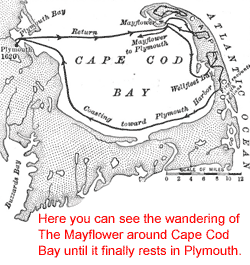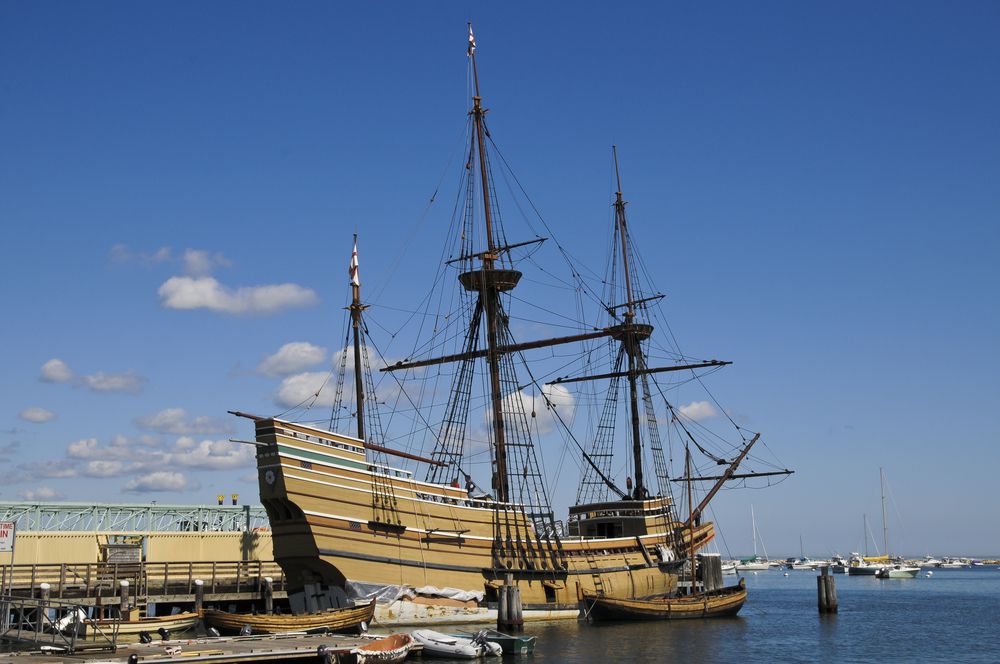The Mayflower II Tour Not Just Another Replica...
The Mayflower II is not just another reproduction ship. It’s a special replica and an important link to America’s past, as you’ll discover here.
The Mayflower voyage of 1620 almost didn’t happen.
The first attempt at crossing for the pilgrims began at Dartmouth, England in August 1620.
But 300 miles out the sister ship “Speedwell” was leaking so badly that both ships returned to Plymouth. Passengers and cargo were all transferred to the Mayflower.
Finally, on September 6th, 1620, just the Mayflower left Plymouth for America, and the historic journey began.
The Mayflower is recorded as a stormy passage of 66 days in 1620 between September – November.
These days we know this period to be during the height of the North Atlantic Hurricane season, and so the rough passage is not surprising to us.

The Voyage of The Mayflower...
Life for the Pilgrims on the Mayflower during the voyage would not have been always pleasant with surviving the storms, the concern over leaks – that almost forced them back – and living in such cramped close quarters for over two months with each other.
After a trip of nearly 3,000 miles traveling at an average speed of 2mph the Mayflower finally anchored in present day Provincetown harbor in Cape Cod on November 11, 1620.
Miraculously only one passenger died on the voyage.
But the Pilgrims decided Cape Cod was not a suitable place for a settlement, and forced north because of the weather and dangerous shoals south of Cape Cod, the pilgrims finally came ashore in late November in present day Plymouth center.
And Plymouth Center is where the Mayflower II replica is docked and where you’ll experience the unforgettable voyage of 1620.

The Mayflower II - Not Just Another Replica...
Nobody really knows what happened to the original Mayflower.
Ship records were notoriously unreliable during this period. And to the owners of the ship, the Atlantic crossing was just another cargo trip to them and a chance for profit.
The Mayflower II replica was constructed in Devon, England between 1955–1957. It was presented to the peoples of America to commemorate the historical links between the two countries, strengthened during World War II.
And yes, the ship really did sail across the Atlantic, and has made many trips up and down the east coast since arriving here in 1957.
The Mayflower II is permanently anchored at State Pier along Water Street in Downtown Plymouth, and not far from the landmark Plymouth Rock.
I adore old ships, although I’ve never had a desire to sail the oceans. A long spell of motion sickness in my youth keeps me close to land.
But the history of the Mayflower is captivating and mystical, and a visit to the ship is a trip back to those early pioneering days.
The Mayflower II replica is authentic and built according to the description and log of the original vessel. A few “modern” improvements to ensure seaworthiness and safety for public visitors were made. But by and large you’re visiting a ship identical to the one the pilgrims sailed aboard.
Ships of this era were notorious for leaking – just like modern day cars, maintenance occupied a lot of time and money for ship owners.
Ans as you walk between the decks, where the passengers would’ve lived, imagine a constant stream of water dripping on your face, and clothes always damp and a musty smell.
If you’ve ever been tent camping in the rain, then you’ll know exactly what life between the decks was about.
The Mayflower Tour and Role Players...
During your Mayflower tour you’ll meet modern-day tour staff, and maybe passengers on the ship role-playing for you. And don’t be surprised if they comment on the rough voyage to you.
You’re encouraged to ask questions but remember the role-playing staff will remain in character, and their views of life and others may seem strange, and even intolerant to you.
They are just conveying 17th century views, which many times show prejudice and lack of respect for anyone deemed as “foreigners,” including the native peoples.
You’ll get to see the passenger’s cramped quarters and the captain’s spacious cabin, and peer into the hold where the food, and supplies of the pilgrims would’ve been stowed.
The tour is self-directed, and takes you through the main deck, orlop and half decks.
At 25 feet wide and 106 feet long with 4 masts and 6 sails, it’s not a large ship.
Marvel at the wonderful display of artifacts and the navigational equipment used by sailors of the time, and how unpredictable a voyage of the time would’ve been for both crew and passenger.
Find your own quiet space on deck and then let yourself be cast back in time.
And if you close your eyes and listen to the gulls overhead maybe you’ll hear the shouts of a sailor as he sights landfall and one journey’s end… and the start of yet another.
Enjoy your visit to Mayflower II. It’s an entertaining reminder of our history and a link back to a monumental voyage.
The Mayflower II tour is not a long tour but is a great compliment to the Plimoth Plantation visit just a few miles away.

Plymouth Lodging Resources:
To discover where to stay deals, and compare rates and amenities with a trusted and professional travel organization then check out Plymouth lodging and accommodations.
